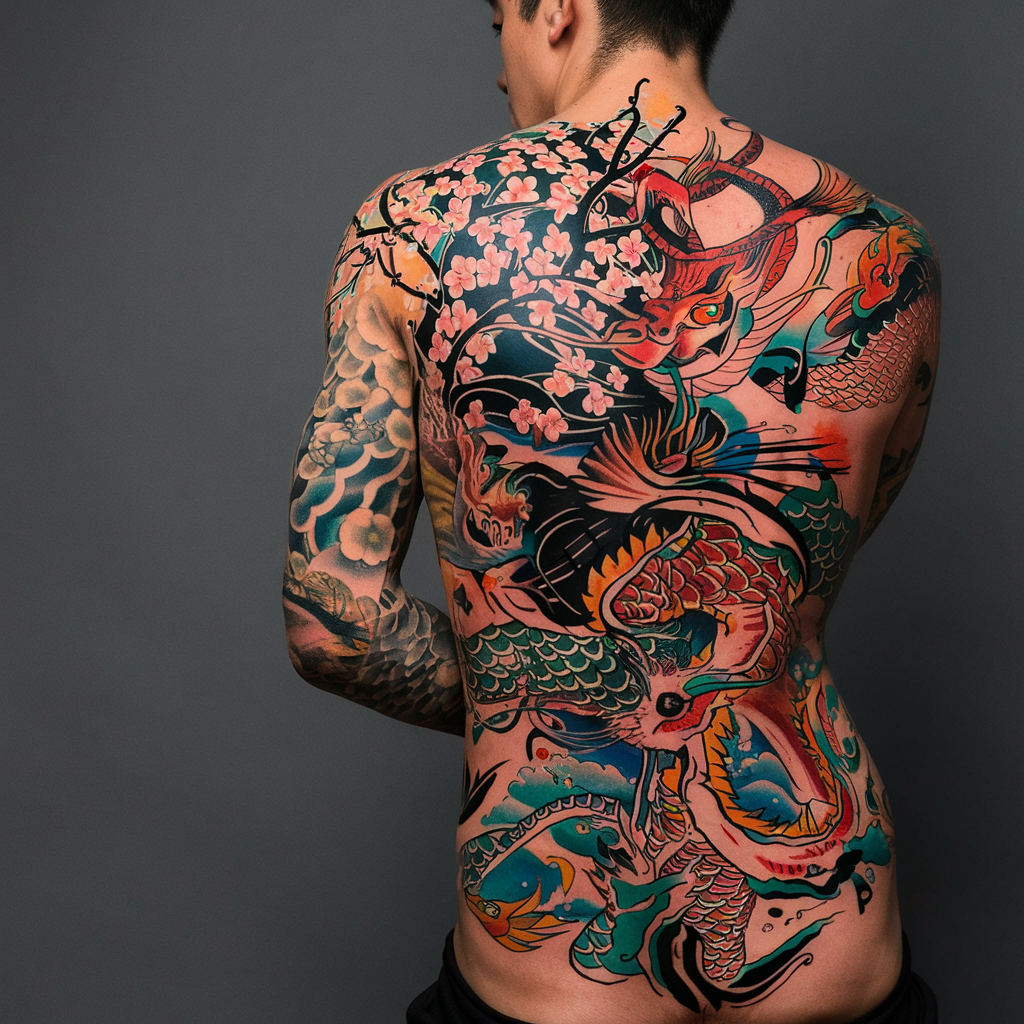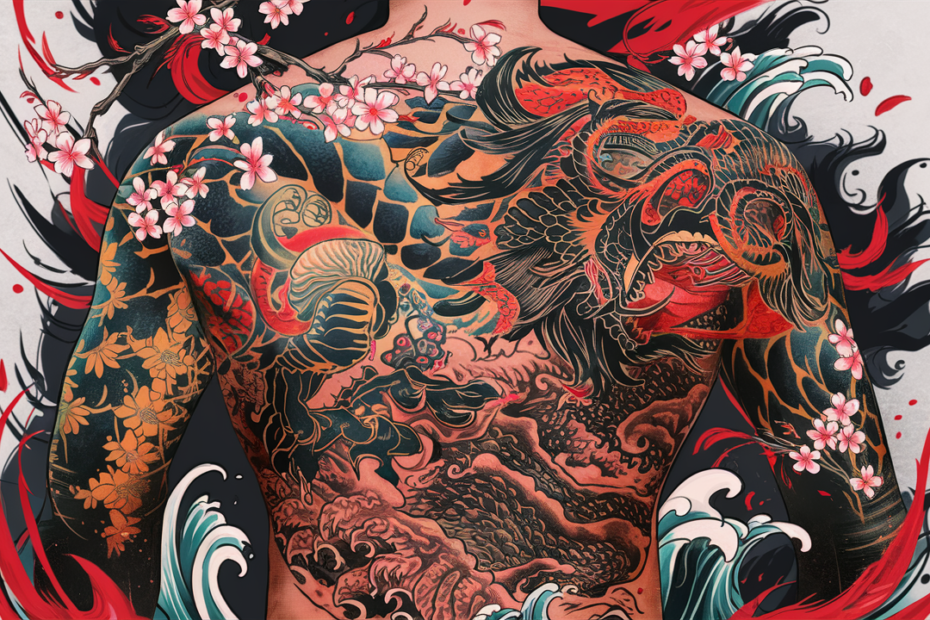Japanese backpiece tattoos, also known as “irezumi,” are renowned for their intricate designs, vibrant colors, and profound symbolism. They are more than just body art; they are a testament to a rich cultural heritage that dates back centuries. In this guide, we will delve into the fascinating world of Japanese backpiece tattoos, exploring their history, design elements, and the process of getting one.
The Art of Japanese Tattooing
Japanese tattooing is a revered art form that has evolved over hundreds of years. Traditional techniques involve the use of hand-poked methods, known as “tebori,” which utilize wooden handles and needles. This method creates unique, detailed artwork that modern tattoo machines often can’t replicate. The influence of Japanese culture is evident in every aspect of the tattoo, from the themes chosen to the placement on the body.
Design Elements in Japanese Backpiece Tattoos
A significant aspect of Japanese backpiece tattoos is the symbolism imbued in each design. Common elements include dragons, koi fish, geishas, and samurai, each carrying deep cultural meanings. Dragons, for instance, represent power and wisdom, while koi fish symbolize perseverance and good fortune. The integration of mythology and folklore adds layers of meaning to these tattoos, making them not just visually striking but also spiritually significant.

Popular Themes in Japanese Backpiece Tattoos
- Dragons and Koi Fish: These creatures are staples in Japanese tattoo art. Dragons are often depicted as protectors, while koi fish are shown swimming upstream, symbolizing determination.
- Geishas and Samurai: Representing grace and strength, these figures highlight the beauty and honor within Japanese culture.
- Floral Designs: Cherry blossoms and lotus flowers are frequently incorporated, symbolizing the transient nature of life and purity, respectively.
Choosing the Right Design
Selecting a design for your Japanese backpiece tattoo is a deeply personal decision. While traditional designs are rooted in history and culture, personalized elements can be added to make the tattoo uniquely yours. Consulting with experienced tattoo artists is crucial to ensure that the final piece aligns with your vision and respects the cultural significance of the artwork.
The Process of Getting a Japanese Backpiece Tattoo
Getting a Japanese backpiece tattoo is a significant commitment. The process begins with thorough planning and preparation, often involving multiple consultations with the artist. Pain management is an important aspect to consider, as backpiece tattoos can be extensive and time-consuming. Understanding what to expect during the sessions can help in managing the experience better.
Aftercare for Japanese Backpiece Tattoos
Proper aftercare is essential to ensure your tattoo heals well and retains its vibrancy. Immediate aftercare involves keeping the tattoo clean and moisturized, avoiding direct sunlight, and following your artist’s specific instructions. Long-term maintenance includes regular moisturizing, using sunscreen to protect the tattoo from fading, and avoiding abrasive clothing.
Cultural Respect and Appropriation
Japanese backpiece tattoos carry deep cultural significance. It’s essential to approach them with respect and understanding, honoring the traditions they represent. Cultural appropriation is a sensitive issue; therefore, educating oneself about the meanings and traditions behind the designs can help in making informed and respectful choices.
Famous Japanese Tattoo Artists
Artists like Horiyoshi III have significantly influenced the world of Japanese tattooing. His legacy and contributions have paved the way for modern artists who continue to innovate while respecting traditional techniques. Discovering the work of influential artists can provide inspiration and appreciation for the art form.
Trends in Japanese Backpiece Tattoos
While traditional elements remain popular, contemporary styles and innovations are emerging in Japanese backpiece tattoos. Social media platforms have played a significant role in spreading these trends, allowing for a fusion of traditional and modern aesthetics. This blend has expanded the appeal and visibility of Japanese tattoos worldwide.

The Significance of Placement
Choosing to place a tattoo on the back offers a large canvas for intricate designs. A backpiece allows for expansive, detailed artwork that can tell a comprehensive story. The placement also impacts the overall aesthetic, providing a dramatic and impactful display.
Cost and Time Investment
Japanese backpiece tattoos are a considerable investment in both time and money. Factors such as the size, complexity of the design, and the artist’s expertise influence the pricing. The time commitment is substantial, often requiring multiple sessions over several months or even years to complete.
Japanese Backpiece Tattoos in Popular Culture
These tattoos have found representation in various media, from movies to TV shows, influencing Western tattoo culture. The portrayal of Japanese backpiece tattoos in popular culture has contributed to their growing popularity and acceptance.
Common Misconceptions
There are several myths surrounding Japanese tattoos, such as their association with criminal activities. In reality, these tattoos are a respected art form with rich cultural significance. Debunking these myths can lead to a better understanding and appreciation of Japanese tattooing.
Conclusion
Japanese backpiece tattoos are a timeless art form that combines intricate design with profound cultural meaning. Whether you’re drawn to their aesthetic appeal or the rich history behind them, these tattoos offer a unique way to express yourself. If you’re considering a Japanese backpiece tattoo, take the time to understand its significance, choose a reputable artist, and prepare for a rewarding journey.
FAQs
What is the meaning behind the dragon in Japanese tattoos?
Dragons in Japanese tattoos symbolize power, wisdom, and protection.
How long does it take to complete a Japanese backpiece tattoo?
It can take several months to years, depending on the complexity and the artist’s schedule.
Are Japanese backpiece tattoos painful?
Yes, they can be painful due to the extensive area covered and the detailed work involved.
How much does a Japanese backpiece tattoo cost?
The cost varies widely based on the artist’s reputation, the design’s complexity, and the time required, typically ranging from several thousand dollars.
Can anyone get a Japanese backpiece tattoo?
Yes, anyone can get one, but it’s important to approach the design with respect and understanding of its cultural significance.



